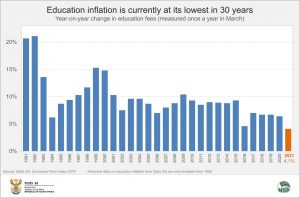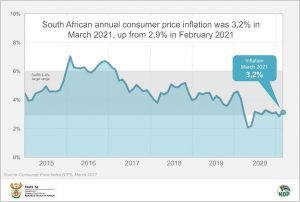Education inflation the lowest in 30 years
Education inflation recorded its lowest annual rate in three decades, according to data from Stats SA’s latest Consumer Price Index (CPI) release.
Stats SA surveys educational institutions and crèches once a year in March. Education fees increased by 4,1% in 2021. Last year’s rise was 6,4%. Historical data shows that this is the lowest increase since at least 1991. 1
Schools were a contributing factor to the slower rise in education fees in 2021. Concerned about what impact higher costs would have on families during the COVID-19 pandemic, many schools implemented marginal increases to the fees that they charge.
Primary and secondary school fees increased by 2,5% and 4,3% respectively in 2021 (compared with 7,3% and 7,6% recorded in 2020). Increases in crèche fees were similarly lower at 2,9% compared with 6,7% in 2020.
Tertiary institutions bucked the trend, however. Fees at universities and universities of technology increased on average by 5,1% in 2021, higher than the 4,7% rise recorded in 2020. University boarding fees increased by 6,5% in 2021, slightly higher than 2020’s 5,9%.
March 2021: Headline inflation back in the 3–6% target range
After a month below 3,0%, annual headline inflation quickened slightly to 3,2% in March from 2,9% in February, rising back into the South African Reserve Bank’s inflation target range of 3–6%.
All product groups are either below or within the SARB target range in March. The highest annual inflation rates were found in food & non-alcoholic beverages (5,7%), education (4,1%), and miscellaneous goods & services (4,0%).
Product groups below the target range were housing & utilities (2,2%), recreation & culture (1,8%), household contents & services (0,7%), clothing & footwear (0,3%), restaurants & hotels (0,1%) and communication (-0,5%).
Oils and fats inflation leads food price increases to 5,7%
Annual inflation for food and non-alcoholic beverages edged up to 5,7% in March from 5,2% in February. Products that recorded annual price rises above the 5,7% average included oils & fats (13,4%), sugar, sweets & desserts (7,4%), milk, eggs & cheese (7,2%), fish (6,8%) and meat (6,7%).
Oils and fat products continue to see large price increases, with an annual rise of 13,4% recorded in March, up from 10,6% in February. The rate in March is the highest since October 2016. Prices climbed across the board within this group, with the largest increases recorded by cooking oil (16,3%), peanut butter (12,4%) and margarine (10,0%).
The annual rate for meat was 6,7% in March, identical to the rate recorded in February. The monthly change was 0,3%. Prices for the following products decreased between February and March: lamb & mutton (-1,1%), sausages (-1,1%) and stewing beef (-0,4%). Chicken products recorded month-on-month price increases, ranging from 0,3% to 2,1%.
Food and beverage products that recorded annual price changes below 5,7% in March included bread and cereals (4,9%), vegetables (3,4%) and fruit (-1,0%).
Annual fuel inflation enters positive territory for the first time in a year
Fuel prices in March 2021 were on average 2,3% higher than they were in March 2020. This is the first time in 12 months that fuel prices have increased on an annual basis. In other words, for the first time in a year, motorists are paying more for fuel than they were 12 months before.
For more information, download the March 2021 Consumer Price Index (CPI) release here.
1 Historical data on education inflation from Stats SA are only available from 1990.
Similar articles are available on the Stats SA website and can be accessed here.
For a monthly overview of economic indicators and infographics, catch the latest edition of the Stats Biz newsletter here.



